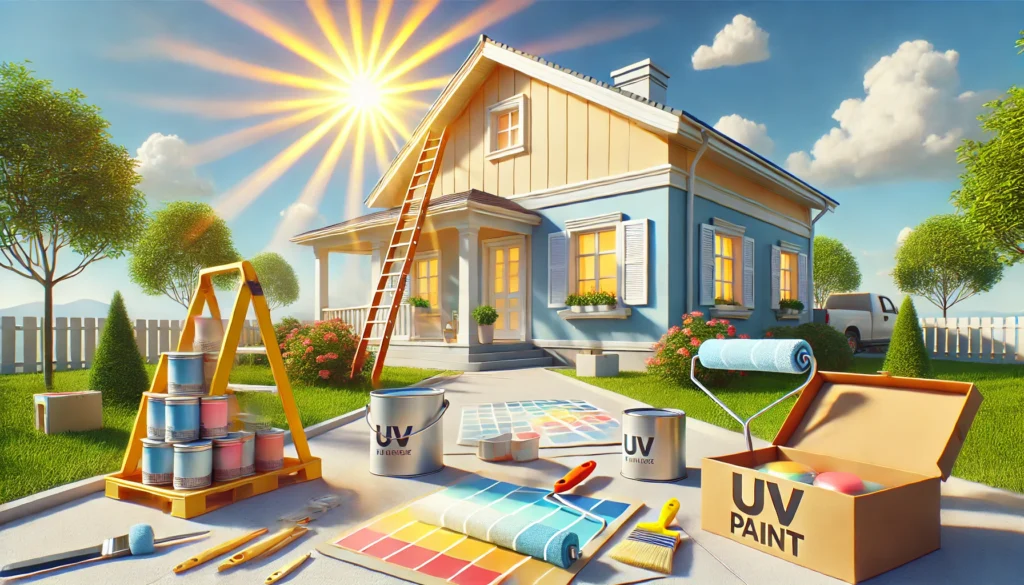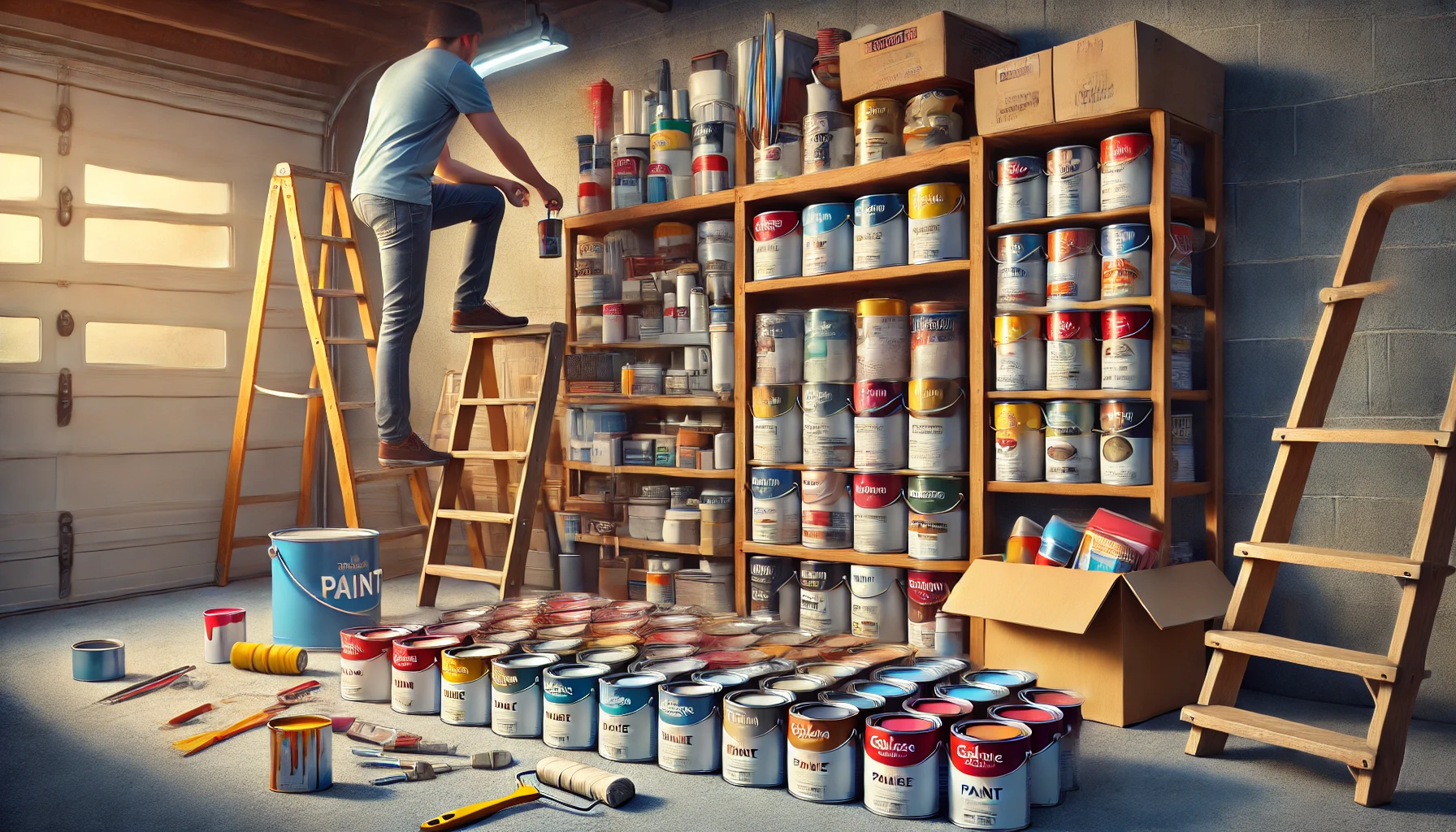Maintaining the paint in your home is more than just a cosmetic concern; it plays a crucial role in protecting your space and saving you money over time.
From preserving aesthetic appeal to preventing surface damage, proper paint care is essential. This guide covers effective maintenance strategies, including:
- Cleaning tips
- Damage repair
- Best practices for storage
Discover the dos and don’ts of paint upkeep, along with ways to safeguard your painted surfaces for lasting beauty and durability. Learn how to keep your home looking fresh and vibrant!
Why is Paint Maintenance Important?
Paint maintenance is absolutely essential for preserving the aesthetic charm of one’s home—think of it as the spa day your walls desperately need. A well-maintained paint job not only elevates the beauty of your abode but also acts as a protective barrier for your valuable investment.
Conversely, neglecting paint care is like inviting paint deterioration to a party; it will inevitably lead to costly repairs and a rather uninviting atmosphere. By regularly attending to paint preservation and cleaning, homeowners can significantly enhance paint durability and longevity, effectively shielding their homes from the elements and the wear and tear of time.
So, let us delve into the reasons why paint maintenance should ascend to the top of every homeowner’s priority list!
1. Protects the Aesthetic Appeal of your Home

A well-maintained paint finish is essential for safeguarding the aesthetic appeal of your home; after all, first impressions matter, especially when visitors and neighbours are sizing up your property.
Selecting the right paint colours and finishes does more than simply enhance the charm of a residence; it acts as a lively reflection of its inhabitants’ personalities. Warm hues can conjure an inviting atmosphere, while cooler tones whisper tranquillity to all who enter.
To maintain that vibrant glow over the years, it is imperative to choose quality paints with UV protection, effectively minimising fading—like a sunscreen for your walls. Regular touch-ups and proper cleaning methods, such as gentle pressure washing, will help preserve that fresh look.
And let’s not forget, a cohesive colour palette throughout the home not only contributes to a visually pleasing environment but also leaves a lasting impression that lingers in the minds of all who cross the threshold.
2. Prevents Damage to Surfaces
One of the notable benefits of paint maintenance lies in its ability to prevent damage to surfaces, effectively prolonging the lifespan of your walls and other areas.
Without regular upkeep, paint can age like cheese left out in the sun—leading to unsightly cracking, fading, and peeling. This not only compromises aesthetic appeal but also opens the door to potentially serious structural dilemmas. Areas exposed to high moisture or relentless sunlight are particularly vulnerable to such deterioration.
By employing effective paint protection strategies, along with meticulous surface preparation techniques, one can proactively mitigate the risk of costly repairs in the future. Investing time and resources into paint maintenance not only safeguards the integrity of surfaces but also cultivates a more attractive and enduring environment.
After all, who wouldn’t want their walls to look as fabulous as the day they were painted?
3. Saves Money in the Long Run
Investing in a robust paint maintenance plan is akin to putting on a well-tailored suit for your home; it not only preserves its charm but also saves a tidy sum over time by sidestepping costly repairs and the frequent chore of repainting.
When homeowners make regular maintenance a priority—think periodic washes and timely touch-ups—they can dramatically enhance the longevity of their paint job. Proper upkeep acts as a superhero against villains like mould growth, fading from relentless sun exposure, and chipping due to tempestuous weather conditions.
For instance, employing specialised cleaning solutions, such as mild detergents or mildew removers, can effectively banish dirt and grime, while high-quality sealants provide a sturdy barrier against moisture’s relentless advances. By weaving these products into their maintenance routine, individuals not only extend their paint’s life but also significantly reduce the need for extensive refinishing, ultimately securing substantial long-term savings.
How to Properly Maintain and Care for Paint?
Maintaining and caring for your paint is no small task; it requires a diligent regimen of regular cleaning, touch-ups, and a maintenance schedule that would make even the most meticulous of homeowners proud.
After all, a well-kept paint job is akin to a well-tailored suit—it speaks volumes about the attention to detail and pride one takes in their home.
1. Regular Cleaning and Dusting
Regular cleaning and dusting are not merely recommendations; they are essential rituals for maintaining the integrity of your paint finish and ensuring it continues to dazzle.
To keep those painted surfaces in pristine condition, it is wise to engage in surface cleaning at least once a month. However, consider giving special attention to high-traffic areas or those prone to dust accumulation—think of it as a little extra love for the spots that see the most action.
Employing a soft microfibre cloth or a damp sponge is a clever way to lift dirt without scratching the surface—no one wants to turn a lovely finish into a canvas of unfortunate marks. When choosing cleaning products, it’s best to stick with those that are pH-balanced and free from harsh chemicals; think of them as the gentle guardians of your paint’s integrity.
For those stubborn stains that refuse to budge, a gentle concoction of warm water and mild dish soap can perform miracles without wreaking havoc on your finish. This approach not only ensures your surfaces maintain their aesthetic charm but also helps to extend the lifespan of your paint, making it a win-win situation for any discerning homeowner.
2. Repairing Any Damages
Promptly addressing any damage is essential for preserving your paint’s integrity, as neglecting minor issues like chips or scratches can lead to a rather unfortunate ageing process over time.
This neglect not only detracts from the visual appeal but could also jeopardise the structural integrity of the surface. Enter the paint touch-up kit, a veritable knight in shining armour for minor imperfections, preventing them from morphing into larger, more expensive headaches.
These kits usually come equipped with all the necessary tools and matching paint, transforming the repair process into a straightforward endeavour. Employing techniques such as feathering the edges of the repair area and applying multiple thin coats can yield results that are nothing short of seamless.
Timely interventions not only elevate aesthetics but also serve as a fortification against moisture infiltration and oxidation, ultimately extending the lifespan of your paint job. In short, a stitch in time saves nine—and keeps your surfaces looking splendid!
3. Touching Up Paint Chips and Scratches
Touching up paint chips and scratches is not merely an aesthetic endeavour; it is a vital component of paint maintenance that ensures your walls exude a sense of uniformity and care.
A few straightforward steps can pave the way for an effective restoration of your painted surfaces. First, one must assemble the necessary tools: a high-quality brush or roller, a reliable paint tin opener, and painter’s tape—because precision is the name of the game. Don’t forget to include a clean cloth and a small container for mixing, as they are the unsung heroes of this endeavour.
Accurate colour matching is paramount; one should not hesitate to take a sample to the local hardware shop for expert assistance. After all, the last thing one wants is a wall that looks like it has a personality disorder.
Maintaining a consistent paint texture is equally important, so stirring the paint thoroughly before use will help avoid any unsightly discrepancies that could evoke unwanted commentary.
By adhering to these guidelines, one can dramatically enhance the success of their touch-up efforts, leaving walls that not only shine but also tell a tale of meticulous care.
4. Proper Storage and Disposal of Paint

The proper storage and disposal of paint not only enhance its longevity but also promote eco-friendly practices and ensure safety within the home.
By mastering the art of maintaining paint in peak condition, homeowners can save a few pounds while keeping their products in tip-top shape. It is imperative to store paint in a cool, dry location, far away from the glaring sun and extreme temperatures—this little tip can work wonders in extending its shelf life.
When the moment arrives to bid farewell to leftover paint, adhering to local disposal guidelines is crucial to prevent any environmental faux pas. Choosing eco-friendly paint options also brings a host of advantages, including lower volatile organic compound (VOC) emissions, which can improve indoor air quality and foster a healthier living space.
These seemingly minor yet impactful adjustments can indeed transform the landscape of home maintenance.
What are the Dos and Don’ts of Paint Maintenance?
Grasping the dos and don’ts of paint maintenance can dramatically enhance the longevity and visual appeal of your painted surfaces, ensuring they remain in tip-top condition.
After all, a well-maintained coat of paint is like a well-tailored suit—always ready to impress and stand the test of time.
1. Do: Use Gentle Cleaning Products
One should certainly opt for gentle cleaning products when tending to painted surfaces, as employing harsh chemicals is akin to inviting a bull into a china shop—both messy and entirely counterproductive.
Selecting the appropriate cleaning agents is paramount for preserving the integrity of any painted area. Mild, pH-balanced solutions, such as a charming concoction of vinegar diluted with water or specific non-abrasive cleaners, can effectively banish dirt without compromising the finish. It’s also wise to consider the type of paint in use; for instance, matte finishes may require a gentler touch than their glossy counterparts.
Choosing products that are free from solvents and harsh abrasives ensures that one’s walls, furniture, or cabinets remain unharmed, thereby extending their lifespan and maintaining their aesthetic appeal. After all, a well-cared-for surface is a happy surface!
2. Don’t: Use Harsh Chemicals or Abrasives
One should certainly steer clear of harsh chemicals or abrasives in their paint maintenance routine, as these formidable foes can wreak havoc on the paint finish, leading to unwanted damage and degradation.
Using such products may strip away the protective layers, dull the colour, or even invite unsightly discolouration over time. Rather than gambling with your investment, it’s prudent to consider gentler alternatives that clean effectively while preserving the integrity of your surfaces.
Household champions like vinegar and bicarbonate of soda can tackle dirt without inflicting harm, while specialised pH-neutral cleaners provide safe cleaning for painted surfaces. By opting for these kinder options, one can maintain the lustre and durability of their paint, all while achieving that fresh, clean look.
Regular maintenance with safe products not only prolongs the life of painted surfaces but also keeps them looking vibrant for years to come.
3. Do: Follow Manufacturer’s Instructions
It is indeed wise to cultivate the habit of adhering to the manufacturer’s instructions for paint application and maintenance frequency to achieve truly optimal results.
Neglecting these guidelines can lead to results that are less than stellar, potentially shortening the lifespan of your paint job. By diligently following the product labels, one not only ensures that proper techniques are employed but also significantly enhances both the immediate visual appeal and the overall durability of the paint.
Whether it’s selecting the perfect primer or mastering the ideal curing time, every detail plays a crucial role in the effectiveness of the paint. Grasping these instructions can help avert issues such as peeling or fading, ultimately saving time and resources on future touch-ups and repaints—because nobody enjoys an uninvited paint disaster.
4. Don’t: Ignore Signs of Damage or Wear
One must not underestimate the subtle yet telling signs of damage or wear on painted surfaces, for early intervention is the key to preserving paint quality and thwarting the escalation of further issues.
Faded colours, peeling, and cracks are not merely aesthetic nuisances; they serve as loud alarms signalling that the protective barrier of the paint has begun to falter, potentially leaving the underlying material vulnerable to moisture and other nefarious elements.
Conducting regular paint inspections is akin to a routine health check-up for your surfaces—essential for identifying these common issues before they spiral out of control. Timely repairs can not only save one’s time but also prevent financial haemorrhaging down the line.
Ignoring these warning signs could lead to far graver complications, such as rot or mould, making it crucial to adopt a proactive stance in evaluating the condition of painted surfaces. After all, it’s far better to nip a problem in the bud than to wrestle with a full-blown disaster later on!
How to Protect Painted Surfaces?
Safeguarding your painted surfaces is not merely a recommendation; it is an imperative for preserving their longevity and ensuring they remain visually captivating in the face of environmental challenges.
After all, nature can be a rather unforgiving critic, and who wants their artistic masterpiece to become a cautionary tale?
1. Use Protective Coatings

Applying protective coatings is arguably one of the most effective strategies for safeguarding painted surfaces against the wear and tear of life—think of it as a suit of armour for your walls.
These coatings come in a variety of types, including clear coats, sealants, and specialised finishes that cater to specific environments. Clear coats are like the glossy icing on a cake, sealing in the beauty of the underlying paint while boosting its durability and aesthetic charm. Sealants, on the other hand, delve deeper, creating a robust bond that’s particularly advantageous for outdoor surfaces bravely facing the elements.
To apply these protective layers, one can resort to the time-honoured techniques of spraying, brushing, or rolling, ensuring an even finish and optimal coverage. By employing these coatings, individuals can dramatically extend the lifespan of their paintwork, all while preserving its vibrancy and integrity against the relentless onslaught of UV rays, moisture, and the occasional abrasive mishap.
2. Avoid Direct Sunlight and Harsh Weather
To extend the life of your paint, it is prudent to steer clear of direct sunlight and the wrath of harsh weather conditions, both of which can contribute to fading and diminished durability.
Excessive UV exposure is rather like a relentless critic, draining the vibrancy from your paint and, over time, causing it to crack and peel as if in protest. Likewise, severe weather phenomena—be it torrential rain, snow, or extreme temperatures—can unleash chaos on your exterior coatings.
To counteract these effects, consider the strategic placement of outdoor furniture and decor in shaded locations or employ awnings and parasol as your faithful sentinels against direct sunlight. Additionally, opting for high-quality paints infused with UV protection can serve as an extra layer of armour, ensuring that your outdoor spaces retain their beauty and remain impeccably maintained, even when faced with nature’s more challenging moods.
3. Be Mindful of Furniture and Decor Placement
Being mindful of furniture and decor placement can work wonders in reducing paint wear and preserving the integrity of your beautifully painted surfaces.
By strategically positioning heavier pieces away from high-traffic areas, one can effectively minimise the risk of scratches and scuffs. Incorporating felt pads under the legs of chairs and tables acts as a savvy barrier, preventing any unwelcome direct contact with the flooring or skirting boards.
Considering the addition of protective covers for frequently used items is a wise move, particularly in spaces where durability reigns supreme. Furthermore, employing corner guards can thwart potential damage in tight spots, saving your walls from untimely nicks.
Establishing a regular cleaning routine will also pay dividends, ensuring that dirt and debris—those sneaky culprits contributing to wear—are kept at bay, thus extending the life of those stunning surfaces you’ve worked so hard to maintain.
Frequently Asked Questions
What is paint maintenance and care?
Paint maintenance and care refers to the regular upkeep and preservation of painted surfaces in order to maintain their appearance and protect them from damage. This can include cleaning, touch-ups, and preventative measures.
Why is paint maintenance and care important?
Proper paint maintenance and care is important because it helps to extend the lifespan of your paint, prevents damage or deterioration, and keeps your surfaces looking fresh and clean. It also helps to prevent the need for costly repainting in the future.
How often should I perform paint maintenance and care?
The frequency of paint maintenance and care will depend on various factors such as the type of paint, the location of the surface, and the level of wear and tear. Generally, it is recommended to perform maintenance and care at least once a year, but high-traffic areas may require more frequent attention.
What are some tips for maintaining and caring for painted surfaces?
Some tips for paint maintenance and care include regularly cleaning surfaces with a mild soap and water, avoiding harsh chemicals or abrasive materials, promptly addressing any chips or scratches, and using a quality paint and primer when repainting. It is also important to ensure proper ventilation and temperature control in painted areas.
How can I prevent paint from fading or peeling?
To prevent paint from fading or peeling, it is important to choose a high-quality paint specifically designed for the surface and location. You should also regularly clean and maintain the paint, avoid exposure to direct sunlight or extreme temperatures, and make any necessary repairs or touch-ups as soon as possible.
Can I perform paint maintenance and care on my own?
Yes, paint maintenance and care can be performed on your own with the right tools and knowledge. However, for larger or more complex projects, it is recommended to consult a professional for best results.
